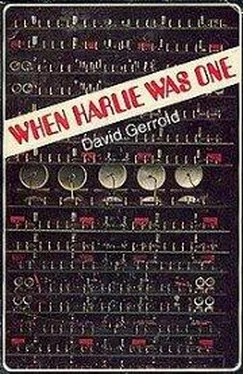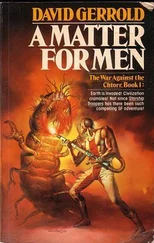David Gerrold - When HARLIE Was One
Здесь есть возможность читать онлайн «David Gerrold - When HARLIE Was One» весь текст электронной книги совершенно бесплатно (целиком полную версию без сокращений). В некоторых случаях можно слушать аудио, скачать через торрент в формате fb2 и присутствует краткое содержание. Год выпуска: 1972, ISBN: 1972, Издательство: Doubleday, Жанр: Фантастика и фэнтези, на английском языке. Описание произведения, (предисловие) а так же отзывы посетителей доступны на портале библиотеки ЛибКат.
- Название:When HARLIE Was One
- Автор:
- Издательство:Doubleday
- Жанр:
- Год:1972
- ISBN:978-0345028853
- Рейтинг книги:3 / 5. Голосов: 1
-
Избранное:Добавить в избранное
- Отзывы:
-
Ваша оценка:
- 60
- 1
- 2
- 3
- 4
- 5
When HARLIE Was One: краткое содержание, описание и аннотация
Предлагаем к чтению аннотацию, описание, краткое содержание или предисловие (зависит от того, что написал сам автор книги «When HARLIE Was One»). Если вы не нашли необходимую информацию о книге — напишите в комментариях, мы постараемся отыскать её.
Nominated for Nebula Award for Best Novel in 1972.
Nominated for Hugo Award for Best Novel in 1973.
When HARLIE Was One — читать онлайн бесплатно полную книгу (весь текст) целиком
Ниже представлен текст книги, разбитый по страницам. Система сохранения места последней прочитанной страницы, позволяет с удобством читать онлайн бесплатно книгу «When HARLIE Was One», без необходимости каждый раз заново искать на чём Вы остановились. Поставьте закладку, и сможете в любой момент перейти на страницу, на которой закончили чтение.
Интервал:
Закладка:
“Is he turned off?” Elzer asked.
“Not hardly.” He indicated the mass of wires at the back of the rack still connecting it to the rest of the framework. “This board that the units are mounted on is a hyper –state piece itself. It saves a lot of connecting wire. A lot of connecting wire.” The rack was about two and a half feet long and a foot wide. It was less than a quarter inch thick. Spaced across it, seemingly in no particular pattern, were more than fifty carefully labeled “black-box” units. They were featureless little nodes, rectangular and dark. Most were less than an inch in length. Others were as long as six. None were thicker than one inch. They were the equivalent of human brain lobes, but they looked like miniature black slabs, casually arranged on a small bookshelf in a random geometric pattern.
“Actually,” explained Auberson, “we could fit these pieces into a space not too much larger than the human brain — well, not these pieces here, but the actual circuitry of HARLIE. It could easily be compressed into a unit the size of a football, but we’ve laid the lobes out like this for easy repair or replacement. The football-sized unit would be more efficient, because general circuit length would be reduced, cutting our overall operation time. But HARLIE’s still considered a prototype unit, so we want the ability to open him up and see what makes him work or not work.”
“Especially ‘not work,’ ” said Elzer.
Auberson ignored it. “Anyway, that’s why we sacrificed some of the compactness of the operation for the ease of a ‘breadboard’ set-up.” He slid the rack back into the frame, snapped the hooks into place, and lowered the dust cover over it.
Elzer touched the plastic cover. His tiny eyes were veiled. “That’s all there is to him, huh?”
Auberson nodded. “Hyper-state circuitry enables us to compress a lot of things into a very small area. Large-scale integration, the process that preceded hyper-state, allowed enough circuitry per inch to reproduce the actions of the human brain in a volume only four times the size of the human head. Hyper-state allows us to duplicate not only cell function, but cell size as well.”
Elzer looked skeptical. Auberson knew what he was thinking and added, “Of course, it’s not much to look at, but it’s the results that count. Each unit you see there — each node — is worth at least ten thousand dollars. The whole case here is more than eleven million dollars. Give or take a few hundred thou.”
Elzer pursed his lips thoughtfully. “It’s the research,” said Auberson. “That’s what costs so much. Also, the planning, the diagramming, the implementation. Also, the careful precision required in construction — those things have to be layered, molecule by molecule. We had to work out new techniques to make some of the larger ones; but then, those units are practically indestructible.”
“An awful lot of money,” Elzer murmured. “Future units will be cheaper,” Auberson replied. “If there are any future units.” Elzer looked around. “If this is all there is to him, why do you need the whole bottom level of the plant?”
Auberson led him through the doors into the large, brightly lit work room. “This is where we monitor the actions of that.” He gestured behind him at the room they had just left. “Each one of those big consoles you see is monitoring the actions of one or more of those slabs.”
Elzer looked about him at several million dollars’ worth of data processors and analyzers. For the most part, they were tall rectangular shapes, or squat rectangular shapes, or long rectangular shapes. Some had windows in which spinning reels of tape were visible. Others had panels of buttons, keys, or bunking lights. Many had TV screens on them, but the diagrams they flashed were meaningless to Elzer’s untrained eyes. “All this for analysis?”
“Mostly. Also for conversations.” Auberson pointed to a cluster of consoles and typers. “HARLIE has twenty or so channels for talking to people, but each of those twenty channels has several consoles to it. HARLIE doesn’t just carry on a conversation with you, he annotates it as he goes along. A separate console keeps a record of all reference texts, equations, and source material that has a bearing on the conversation. That requires a highspeed printer. Also, there’re auxiliary consoles to each channel, so other people can monitor the conversation, or participate in it.”
Elzer nodded. “I understand.”
“We’ve begun to move out of the prototype stage,” Auberson said. “We’re starting to use him for non-essential tasks, the working out of auxiliary programs, et cetera. We’re going slow, taking it one step at a time, making sure we’ve mastered each phase before going on to the next. We’re at the point now where it’s easier to set him an actual problem than to try and devise a suitable test. So far, he’s done all right. A few of his solutions have been rather unorthodox, but not unworkable.”
“Like for instance?” the bookkeeper prompted.
“Well, the Timeton plant contract, for example. We used HARLIE as a disinterested third party to monitor both sides’ demands and proposals, and offer, if possible, a solution of his own. The union’s requests were routine: higher pay, increased benefits. But the plant was in a money squeeze because of a recent expansion and failure to match expected earnings. Timeton was considering a cutback at the time.”
Elzer nodded. “I remember the situation. It was settled, wasn’t it?”
“Right. HARLIE’s solution. He began by requesting an efficiency study with specific attention to how much time was spent in actual production and how much on setting up, breaking down, and so on. He found that it was necessary to prepare the equipment for production four times a day: in the morning, after the coffee break, after the lunch break, and after the second work break. That’s at least ten, usually fifteen, minutes per set-up. Same thing for shutting down. That was costing them two hours of production time per day, or ten hours per work week. They were spending too much time getting ready and cleaning up, and not enough time actually working. HARLIE suggested giving everybody Fridays off. Add an hour and a half to each of the other four work days and boost wages enough to compensate for the loss of those two ‘so-called’ working hours. Timeton found they could produce as much in four nine-and-a-half-hour days as they could in five eight-hour days. What they’d done was to trim away those two wasted hours of cleanup and preparation time and spread the remaining work hours across the rest of the week. They increased their ratio of production time by doing so.”
“Hm,” said Elzer. “How’d the union take it?”
“Oh, they were startled at first, but they agreed to give it a try. After a few weeks they were as enthusiastic about the plan as anyone. After all, it gave the men more time with their families. Timeton was pleased because it allowed them to cut costs without cutting production. In fact, production actually went up. Like I said, it was an unorthodox solution — but it worked. And that’s what counts. The nice thing about it was that the plan was good for both sides.”
Elzer nodded vaguely. He didn’t need to have any more explained to him. He glanced about again. His eyes lit on a figure at a console. “What’s that?” he pointed.
Auberson looked. Elzer was referring to a thirteen-year-old girl; she was sitting in the corner, thoroughly engrossed in her “conversation” with HARLIE. “Oh,” said Auberson. “She’s another one of our non-essential, but fully operational programs.”
“Huh?”
“Project Pedagogue.”
“Computer teaching?”
Читать дальшеИнтервал:
Закладка:
Похожие книги на «When HARLIE Was One»
Представляем Вашему вниманию похожие книги на «When HARLIE Was One» списком для выбора. Мы отобрали схожую по названию и смыслу литературу в надежде предоставить читателям больше вариантов отыскать новые, интересные, ещё непрочитанные произведения.
Обсуждение, отзывы о книге «When HARLIE Was One» и просто собственные мнения читателей. Оставьте ваши комментарии, напишите, что Вы думаете о произведении, его смысле или главных героях. Укажите что конкретно понравилось, а что нет, и почему Вы так считаете.












